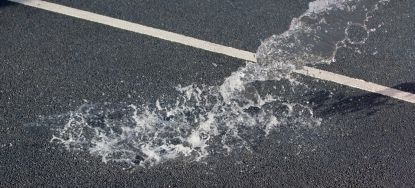Concrete. So boring and plain that it’s often overlooked, but always there for you when you fall. Concrete has been exacerbating water crises in cities around the world. However, the work of one concrete company could improve the situation.
By Phoebe Vowles-Webb
In urbanised areas, more severe flooding is occurring because ground water has nowhere to go once drains are full. This is because concrete has paved the way to our post-modern lives, as a smooth and strong material for vehicles and living. It’s everywhere. So when there are hurricanes or torrential rain, all that we have to divert the water from our homes are drainage systems – a very finite store. We simply can’t collect and divert all the water to stop flooding and polluting occurring. Hurricane Katrina is just one example of existing artificial solutions failing to reduce the effects of severe weather.
This, however, is all going to change. A new type of concrete has been invented: Lafarge Tarmac’s Topmix Permeable. It is water absorbent, every metre2 is able to take in 600 litres a minute. The water is dispelled to the earth below. This new concrete could prevent future post-disaster crises such as stagnant sewage flooding in American towns like New Orleans, and residential areas in England that experience destructive flooding.
Ongoing Climate Change means that many countries are receiving heavier rainfall, a phenomena set to continue in the near future. Topmix Permeable could help cities and other heavily concreted areas deal with this. On a more mundane level, this new concrete could be used to pave roads to stop passers-by getting sprayed with puddle water by cars. It could even be adapted for swimming pools to stop the sides getting slippery. These are not priorities, but could improve everyday life for many people.

Not only are floodwater and rain taken away to reduce the chance of flooding, but it is also taken before it becomes polluted. With conventional drainage systems, water has to run along roads and can become contaminated with sewage, making it harder and more costly to purify. More importantly, polluted flood water can become extremely dangerous for residents in these urban areas, often imbued with substances like car cleaner and animal droppings. Topmix Permeable prevents the pollution of the water it absorbs.
Sending the water down to the earth would improve ground water levels. This would lessen the chances of houses sinking as clay or earth layers shrink beneath them. Ground water also makes up 30.1% of the Earth’s fresh water, with 50% of Americans using it for drinking water. In this way Topmix Permeable will have more far-reaching effects than dispersing sudden floods; it could improve our drinking water supply.
It seems to be a perfect answer to flooding. That is before we start talking about winter. Water expands when it freezes, and could greatly endanger the very structure of this concrete, causing the entire expanse to be unusable. This concrete can therefore only be used in areas where it is unlikely to get to 0°c. And of course, sending rain and flood water to the ground water level may not be the answer, as if it rises too much it can flood underground structures like basements, and damage the foundations of houses. We have to ensure some sort of balance between the two extremes of closing of access to ground water and relying on it too heavily.
A lot of American and British cities that experience flooding and heavy rainfall will be shut out of this invention, but Topmix Permeable could still be used for southern state cities and those in other countries. Southern European and Asian countries, as well as cities like Gaborone in Botswana (that experience monsoon seasons) could benefit from this concrete. With the occasional reversal of the El Niño effect in Australia, their residential areas could benefit from this tarmac, too.
Lafarge Tarmac has created an intuitive design that is still as strong and reliable as regular concrete, and gives a more effective and cheaper solution to the expensive and undependable drainage systems we currently use. It’s not a perfect solution, but it could alleviate our current water drainage problems in cities, and protect citizens across the globe.


Very interesting in places where rainfall is very high
LikeLike